1. Application examples
1)Splicing board
In the 1960s, Toyota Motor Company first adopted tailor-welded blank technology. It is to connect two or more sheets together by welding and then stamp them. These sheets can have different thicknesses, materials, and properties. Due to the increasingly higher requirements for automobile performance and functions such as energy saving, environmental protection, driving safety, etc., tailor welding technology has attracted more and more attention. Plate welding can use spot welding, flash butt welding, laser welding, hydrogen arc welding, etc. At present, laser welding is mainly used in foreign research and production of tailor-welded blanks.
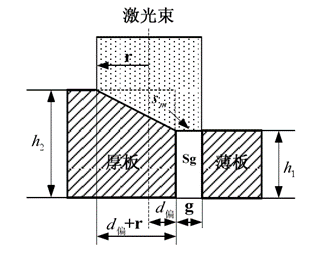
By comparing the test and calculation results, the results are in good agreement, verifying the correctness of the heat source model. The width of the weld seam under different process parameters was calculated and gradually optimized. Finally, the beam energy ratio of 2:1 was adopted, the double beams were arranged in parallel, the large energy beam was located at the center of the weld seam, and the small energy beam was located at the thick plate. It can effectively reduce the weld width. When the two beams are 45 degrees from each other. When arranged, the beam acts on the thick plate and the thin plate respectively. Due to the reduction of the effective heating beam diameter, the weld width also decreases.
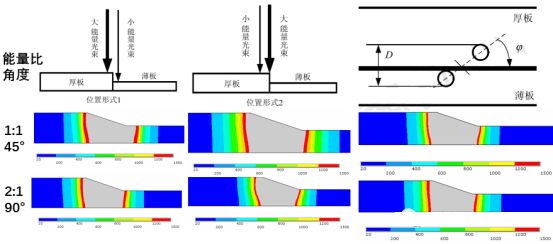
2)Aluminum steel dissimilar metals
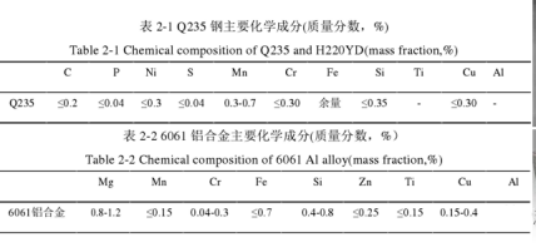
The current study draws the following conclusions: (1) As the beam energy ratio increases, the thickness of the intermetallic compound in the same position area of the weld/aluminum alloy interface gradually decreases, and the distribution becomes more regular. When RS=2, the thickness of the interface IMC layer is between 5-10 microns. The maximum length of free “needle-like” IMC is between 23 microns. When RS=0.67, the thickness of the interface IMC layer is below 5 microns, and the maximum length of free “needle-like” IMC is 5.6 microns. The thickness of the intermetallic compound is significantly reduced.
(2) When parallel dual-beam laser is used for welding, the IMC at the weld/aluminum alloy interface is more irregular. The IMC layer thickness at the weld/aluminum alloy interface near the steel/aluminum alloy joint interface is thicker, with a maximum thickness of 23.7 microns. . As the beam energy ratio increases, when RS=1.50, the thickness of the IMC layer at the weld/aluminum alloy interface is still greater than the thickness of the intermetallic compound in the same area of the serial dual beam.
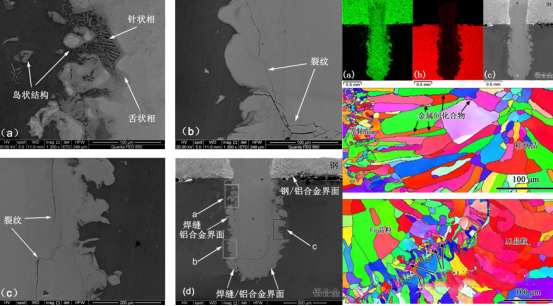
3. Aluminum-lithium alloy T-shaped joint
Regarding the mechanical properties of laser welded joints of 2A97 aluminum alloy, researchers studied the microhardness, tensile properties and fatigue properties. The test results show that: the weld zone of the laser welded joint of 2A97-T3/T4 aluminum alloy is severely softened. The coefficient is around 0.6, which is mainly related to the dissolution and subsequent difficulty in precipitation of the strengthening phase; the strength coefficient of the 2A97-T4 aluminum alloy joint welded by IPGYLR-6000 fiber laser can reach 0.8, but the plasticity is low, while the IPGYLS-4000 fiber laser welding The strength coefficient of laser welded 2A97-T3 aluminum alloy joints is about 0.6; pore defects are the origin of fatigue cracks in 2A97-T3 aluminum alloy laser welded joints.
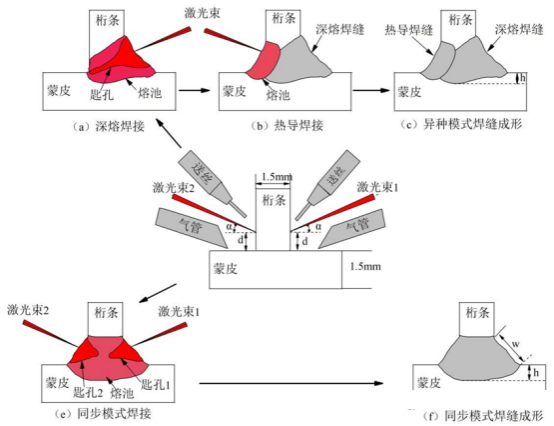
In the synchronous mode, according to different crystal morphologies, FZ is mainly composed of columnar crystals and equiaxed crystals. The columnar crystals have an epitaxial EQZ growth orientation, and their growth directions are perpendicular to the fusion line. This is because the surface of the EQZ grain is a ready-made nucleation particle, and the heat dissipation in this direction is the fastest. Therefore, the primary crystallographic axis of the vertical fusion line grows preferentially and the sides are restricted. As the columnar crystals grow toward the center of the weld, the structural morphology changes and columnar dendrites are formed. In the center of the weld, the temperature of the molten pool is high, the heat dissipation rate is the same in all directions, and the grains grow equiaxially in all directions, forming equiaxed dendrites. When the primary crystallographic axis of the equiaxed dendrites is exactly tangent to the specimen plane, obvious flower-like grains can be observed in the metallographic phase. In addition, affected by the supercooling of local components in the weld zone, equiaxed fine-grained bands usually appear in the welded seam area of the synchronous mode T-shaped joint, and the grain morphology in the equiaxed fine-grained band is different from the grain morphology of EQZ. Same appearance. Because the heating process of heterogeneous mode TSTB-LW is different from that of synchronous mode TSTB-LW, there are obvious differences in the macromorphology and microstructure morphology. The heterogeneous mode TSTB-LW T-shaped joint has experienced two thermal cycles, showing double molten pool characteristics. There is an obvious secondary fusion line inside the weld, and the molten pool formed by thermal conduction welding is small. In the heterogeneous mode TSTB-LW process, the deep penetration weld is affected by the heating process of thermal conduction welding. The columnar dendrites and equiaxed dendrites close to the secondary fusion line have fewer subgrain boundaries and transform into columnar or cellular crystals, indicating that The heating process of thermal conductivity welding has a heat treatment effect on deep penetration welds. And the grain size of the dendrites in the center of the thermally conductive weld is 2-5 microns, which is much smaller than the grain size of the dendrites in the center of the deep penetration weld (5-10 microns). This is mainly related to the maximum heating of the welds on both sides. Temperature is related to subsequent cooling rate.
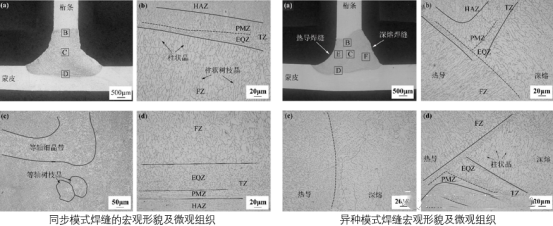
3) Principle of double-beam laser powder cladding welding
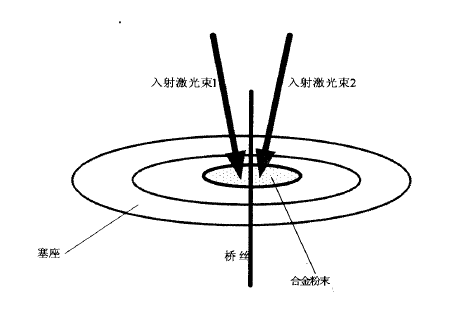
4) High solder joint strength
In the double-beam laser powder deposition welding experiment, since the two laser beams are distributed side by side on both sides of the bridge wire, the range of the laser and the substrate is larger than that of single-beam laser powder deposition welding, and the resulting solder joints are vertical to the bridge wire. The wire direction is relatively elongated. Figure 3.6 shows the solder joints obtained by single-beam and double-beam laser powder deposition welding. During the welding process, whether it is a double-beam laser welding method or a single-beam laser welding method, a certain molten pool is formed on the base material through heat conduction. In this way, the molten base material metal in the molten pool can form a metallurgical bond with the molten self-fluxing alloy powder, thereby achieving welding. When using a dual-beam laser for welding, the interaction between the laser beam and the base material is the interaction between the action areas of the two laser beams, that is, the interaction between the two molten pools formed by the laser on the material. In this way, the resulting new fusion The area is larger than that of single-beam laser welding, so the solder joints obtained by double-beam laser welding are stronger than single-beam laser welding.
2. High solderability and repeatability
In the single-beam laser welding experiment, since the center of the focused spot of the laser directly acts on the micro-bridge wire, the bridge wire has very high requirements for the laser welding process parameters, such as uneven laser energy density distribution and uneven alloy powder thickness. This will lead to wire breakage during the welding process and even directly cause the bridge wire to vaporize. In the double-beam laser welding method, since the focused spot centers of the two laser beams do not directly act on the micro-bridge wires, the stringent requirements for the laser welding process parameters of the bridge wires are reduced, and the weldability and repeatability are greatly improved. .
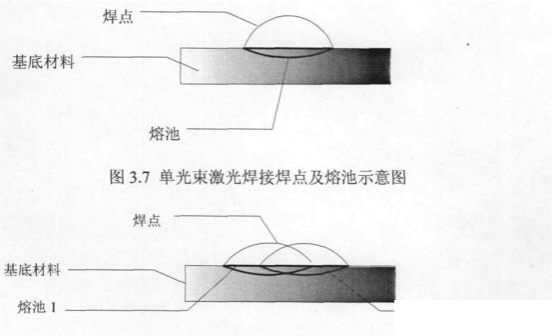
Post time: Oct-17-2023
















